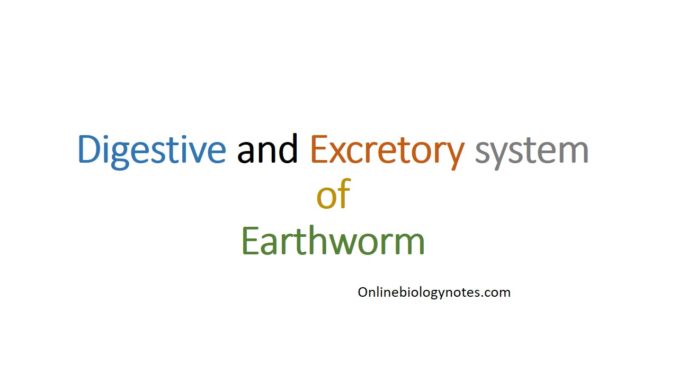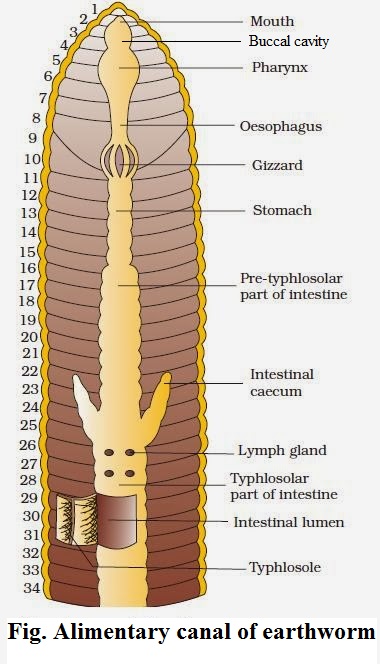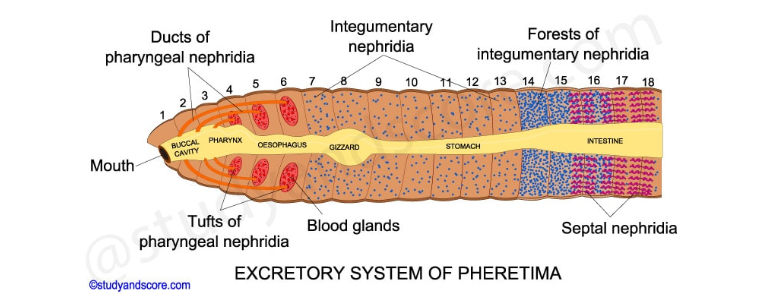
Digestive system of earthworm:
- Details on digestive and excretory system of earthworm
Structure of Alimentary canal of Earthworm
- Alimentary canal is a long straight tube extending from the first segment to the last segment of an earthworm’s body.
- It represents a tube within a tube body plan.
- It begins with an anterior mouth or prostomium and ends in the posterior anus.
- Along with it, it includes buccal cavity, pharynx, oesophagus, gizzard, stomach and intestine.
- Mouth:
- It is a semicircular structure situated in the first segment called the peristomium just below the hood like prostomium.
- It is highly elastic in nature and can protrude out and in.
- Buccal/oral cavity:
- It lies within the second and third segments.
- Pharynx:
- Following the buccal cavity, the pharynx lies in the 4th, 5th, and 6th segments.
- It is thick and highly muscular.
- The pharyngeal cavity is divided into two types:
- Dorsal chamber (ciliated): They possess salivary glands in the outer region, that are formed by the chromophil cells (secrete saliva, i.e., mucus) and proteolytic enzymes for the digestion of the proteins.
- Ventral chamber (non-ciliated): It is non-glandular and is termed as conducting chamber.
- The effective organ for food digestion in earthworm is the pharynx.
- Oesophagus:
- It extends from 5th to 7th segments.
- They are quite thin, non-glandular and do not possess any muscular folds.
- Gizzard:
- It lies in the 8th and 9th segments.
- It acts as grinder hence termed as grinding machine, i.e. it aids in grinding of soil particles mixed with organic matter and other decayed materials.
- The wall of the gizzard is made up of an outer layer of the circular muscles, a single layer of epithelial cells and an innermost thick layer of cuticle that is secreted by epithelial layer.
- The contraction and relaxation of circular muscles cause the easy mastication of food and soil.
- Stomach:
- The gizzard leads to the stomach, that is present from second half of 9th segments upto 14th segments.
- It is a longer tube with short narrow cavity termed as glandular chamber.
- The wall of stomach consists of calciferous glands whose secretion causes the neutralization of acidity of soil.
- Intestine:
- It extends from 15th to the last segment.
- An internal long fold of dorsal wall is present after the 26th segment which is termed as typhlosole.
- Typhlosole is responsible for increasing the surface area of absorption.
- Intestine can be divided into three types on the basis of typhlosole:
- i) Pre-typhlosolar region:
- It extends from 15th to the 25th segment.
- It is highly glandular.
- A pair of short and conical intestinal caecae is present on the 26th segment.
- ii) Typhlosolar region:
- It lies from 26th to 75-95last segment.
- It is glandular and is highly absorptive.
- iii) Post-typhlosolar region:
- It is the region after typhlosole.
- It lies in the last 23-25 segments (76-96 to 100-120).
- It is also termed as rectum and is absorptive in nature.
- Anus:
- It is present in last/anal/pygidial segment.
- It is a vertical, slit-like, small terminal aperture.
- The defecation of worm-castings occurs through this aperture.

Physiology of digestion in Earthworm :
- In pharynx the food is mixed with saliva secreted by glandular cells of pharyngeal bulbs.
- Saliva contains mucin and proteolytic enzymes.
- Within gizzard, food is grinded into fine powder. The main reason for ingesting soil is to produce friction during breakdown of food.
- From gizzard the food reaches into stomach.
- The gland cells of stomach secrete proteolytic enzymes, which convert proteins and small peptides into amino acids.
- In stomach, the neutralization of food by calcites (CaCO3) and digestion of rest of the proteins takes place.
- In intestine complete digestion of proteins, polysaccharides, fat, chitin, and cellulose takes place.
- Proteins when acted by proteases break down to peptones and proteoses.
- Further, peptones and proteoses are acted upon by proteases to form amino acids.
- The amylase enzyme is responsible for breakdown of polysaccharides into disaccharides.
- The lipase enzyme converts fats or lipids into fatty acids.
- Cellulose is also converted to disaccharides by lipase.
- Chitin is converted to disaccharides by lipase.
- After completion of digestion, both the digested and undigested foods pass to typhlosolar region.
- Here, the digested substances are absorbed by typhlosole and are circulated throughout the blood vascular system.
- The portion of food and soil that remained, passes to post typhlosolar region for storage.
- Finally, such substances are removed from the anus in the form of castings.
Excretory system of Earthworm:
- The nephridia are the excretory organs of earthworm.
- They are ectodermal in origin.
- Nephridia are analogous to kidneys of vertebrates.
- Nephridia are present in all segments of the body except in first 3 segments and last segments.
- In earthworm, the nephridia functions for the removal of the excretory wastes both from blood and the coelomic fluid.
- There are 3 types of nephridia based on the structure and location:
- Septal nephridia or typical nephridia: Enteronephric nephridia
- Integumentary nephridia: Exo-nephric nephridia
- Pharyngeal nephridia: Enteronephric nephridia
1. Septal nephridia (Enteronephric nephridia):
- Septal nephridia are the largest nephridia.
- They are located in both sides of septum in each segment, behind the 15th to 2nd last segment.
- Each inter-segmental septum possess two rows of septal nephridia numbering 80-100 on each septum.
- Each septal nephridium has 4 parts: Nephrostome (nephridiostome or ciliated funnel), neck, body of nephridium and terminal duct.
- Septal nephridium is distinguished from pharyngeal nephridia in having nephrostome.
- Septal nephridia are the only nephridia with nephrostome or funnel.
- The terminal duct opens into septal excretory canal.
- These canals in turn open into two supra-intestinal excretory canals, so called enteronephric nephridia.
2. Integumentary nephridia:
- These are smallest nephridia.
- These are V-shaped in structure and are the most numerous types of nephridia.
- Integumentary nephridia are scattered in the body wall in all segments except in the first 7 segments and last segment.
- In each segment, there are about 200-250 integumentary nephridia.
- However, in the clitellar segments, the number is 10 times more than in ordinary segments.
- Hence, clitellar region is also termed as the forest of nephridia.
- As the terminal duct of integumentary nephridium is internally closed, each nephridium opens upon the body surface through nephridiophores.
- Hence, these nephridia are referred as exonephric nephridia.
- No nephridiopores are found in integumentary nephridia.
3. Pharyngeal nephridia:
- Pharyngeal nephridia (3 pairs) occurs as paired tufts on either side of pharynx and oesophagus.
- One pair each is present in 4th, 5th, and 6th segments.
- Each of these tufts comprises of hundreds of pharyngeal nephridia as coiled tubes only.
- The terminal duct of nephridia of each tuft open into a common pharyngeal nephridial duct or the common excretory duct.
- Thus, there are three pairs of common pharyngeal nephridial duct.
- They run upward parallel with ventral nerve cord and open into alimentary canal.
- Ducts from 4th and 5th segments open into the pharynx in 4th while those from 6th segment open into buccal cavity in 2nd.
- As these nephridia directly open into gut (buccal cavity and pharynx), they are of enteronephric type.
- Pharyngeal nephridia are also termed as pepto-nephridia.
- Earthworms are mainly ureotelic as their chief excretory product is urea (urea-50% and ammonia-45% and other 5%).
- The chloragogen cells excrete silicates consumed along with the food by Pheretima.

Summary points on Earthworm digestive and excretory system:
- The alimentary canal comprises of mouth, buccal cavity, pharynx, oesophagus, gizzard, stomach, intestine and anus.
- Pharynx lies in the 4th, 5th, and 6th segments.
- The role of typhlosole is to increase the surface area of absorption.
- Gizzard acts as a grinder for soil particles along with food.
- Various enzymes like amylase, proteases and lipase are engaged during digestion.
- Pharynx is the effective organ for digestion.
- Nephridia are the excretory organs for earthworm and are of three types.
- Septal nephridia are the largest nephridia and integumentary nephridia are the smallest ones.
- One pair each of pharyngeal nephridia is present in 4th, 5th, and 6th segments.
- Earthworms are mainly ureotelic.
